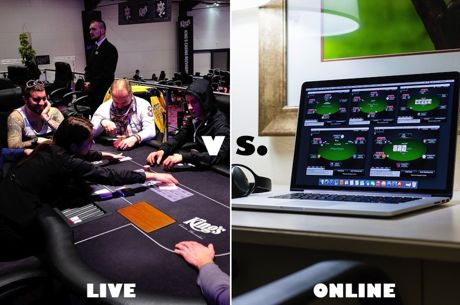10 More Hold'em Tips: Overbetting

You're in a no-limit hold'em tournament. The board shows 9?K?3?10?4? and after raising preflop and leading both the flop and turn with your K?K? for top set, you decide to check to your opponent who has been calling the whole way. You wince as he bets more than the size of the pot, putting you to a tough decision.
Welcome to overbetting.
An "overbet" most often refers to a postflop bet that approaches or exceeds the size of the pot, although the term can be used more generically to describe any bet that is more than typical given the circumstances. In a $1/$2 NL game where the opening raises are usually around four to five times the big blind, a player who opens for $20 can be said to be overbetting. So, too, is the player in our example overbetting with his big river bet.
The overbet isn't a frequently used play in no-limit hold'em, except perhaps in the loosest, most aggressive of games. Most often it is an relatively rare play that only comes about in special circumstances, at least among players who understand when and where to make an overbet.
Very often the overbet is viewed as a "polarizing" bet �� either representing the nuts or a bluff �� although that depends on the situation. In that hand above, the player making the overbet might have turned a king-high straight or rivered a diamond flush, or he might have nothing at all and is betting big as a bluff. Even with top set of kings, you're facing a not-so-simple decision.
In some cases, a player who overbets is actually not being especially mindful about it, and in fact at times overbetting can be viewed as a sign that a player is inexperienced and/or doesn't understand pot odds or the math of the game.
A player who often open-raises for too much before the flop, or who leads with a pot-sized (or larger) bet on the flop sometimes is occasionally showing he or she is a novice player. In fact, overbetting like this can often be a more reliable "tell" letting you know about a player's relative skill level than are other observable actions or behaviors.
Let's talk, though, about some of the reasons why skilled players sometimes overbet.
Overbetting to Price Out Draws
In the hand above, say you reached the turn with your K?K? and the board showing 9?K?3?10?. While the ten on the turn would have completed a straight for a player holding QxJx, you suspect instead the player hasn't gotten there quite yet, although could have clubs, diamonds, and/or a gutshot going to the river. Overbetting here would be a strategy to prevent allowing your opponent to see the river card too cheaply, making the pot odds unfavorable for calling.
To make the math easy, let's say there is 7,500 in the pot and you decide to make an exactly pot-sized bet of 7,500 �� i.e., an overbet. That would give your opponent 2-to-1 pot odds to call and see the river, which means the player would need to have a better than 33% chance of completing a draw on the river for the call to be profitable. Let's give him a hand like A?Q? �� both a flush draw and a gutshot straight draw.
The player actually has only 10 outs to beat your set �� the non-pairing diamonds and jacks �� which is a little less than a 23% chance. The player might think he has 12 outs (if he doesn't put you on a set), but even then he's only about 27% to make his straight or flush. The overbet prices him out of calling and chasing his draw (unless he thinks he can win more from you on the river if he hits it, using "implied odds").
Overbetting for Value
Going for value is probably the most frequent reason for overbetting. Say you were the other player in our example, and hit that nut flush when the diamond came on the river. Making the big overbet is a way of maximizing the value of your big hands, although it can also scare off players from calling you at all, thereby reducing the size of the pots you win.
Generally speaking overbetting for value works best in spots where your opponent is likely also to have a strong hand, though not as strong as yours. If you knew, for instance, your opponent had a set of kings when you rivered your flush, overbetting would be a good idea as a hand that strong is often hard to fold.
The postflop action will clue you in as well regarding the likely strength of your opponent's hand. If your opponent has been checking it down and committing very little pre-river, he's less likely to have something strong enough to call an overbet, meaning a smaller value bet is more preferable. But if he's been betting the whole way, overbetting might work, especially since the pot is already bigger (and more enticing) even before you make that big bet.
Overbetting as a Bluff
Overbetting as a bluff is an obviously risky play to make, since getting called will cost you more than if you had made a smaller bet when bluffing. It can be a profitable play to make, though, especially in tournament situations where players may be more willing to fold stronger hands in order to avoid becoming short-stacked or eliminated.
As with any bluff, the "story" that precedes your big bet has to make sense for the bluff to succeed, having been adequately prepared for by your actions on the preceding streets. Having some idea that your opponent does not have an especially strong hand but something of medium-to-weak value helps, too. Overbet bluffs that fail often do so because the opponent against whom the bluff is being made turns out to have the exact hand the bluffer is representing �� e.g., the nuts �� or something close to it.
Overbet bluffing is often not a good idea when playing online poker at lower limits or the "micros." Betting $1.50 into a $0.75 pot might seem like a crazily-large overbet, technically speaking, but many players are instead going to compare that $1.50 not to the size of the pot but to the price of something in the real world. They'll gladly call you down for the price of a taco.
Overbetting According to Opponent
Speaking of the lower stakes games, there you'll find overbetting will be much less conspicuous, at least in most cases. Players at such limits aren't paying attention to bet sizing or whether or not you are "balancing" your overbets for value and as bluffs. Against such players you will likely do well to overbet for value more often than usual, and overbet as a bluff less often (or perhaps not at all).
Meanwhile against certain players an overbet will often be instinctively read as a bluff. "Why so much?" they'll ask (either to themselves or out loud), as they talk themselves out of believing you have a strong hand and into calling you. If you happen to have some history with a given player �� say, you've been winning against the player a lot, especially recently �� an overbet for value can work well, too, as the player's frustration will compel a call with a medium or even weak hand.
When overbetting as a bluff, also be mindful of the relative tightness of your opponent. In some cases making that bluff just a bit bigger can be enough to induce the fold you want, whereas a smaller or "normal"-sized bluff will not.
Conclusion
Lastly, keep in mind your own image whenever attempting an overbet. As we mentioned, down at the micros your image isn't so much of a concern, but against savvy, attentive players you want to consider the larger context of your overbet.
Does your image suggest you to be a strong, knowledgeable player with an understanding of the strategy behind overbetting? That's when an opponent will likely think of you as being "polarized" �� either having the nuts or nothing at all. Or is your image such that your opponents may not give you as much respect, not realizing you are capable of overbetting for value (or as a bluff)? That might be a spot where an overbet is especially confusing for others to read.
The overbet is usually a rare enough play that it won't matter much if others have seen you do it before. That said, if you have overbet in the recent past (or against the same player), that can be very important in terms of your image and what your opponent might be thinking when you do it again.
Also in this series...
- Game Selection
- Playing Weak Aces
- Making the Squeeze Play
- The Stop-and-Go
- The Float Play
- Should You Ever Limp-Reraise?
- Stealing and Restealing
- Light Three-Betting and Four-Betting
- Understanding Expected Value
Ready to take a seat at the table? Put these hold'em tips into practice at partypoker.
Be sure to complete your PokerNews experience by checking out an overview of our mobile and tablet apps here. Stay on top of the poker world from your phone with our mobile iOS and Android app, or fire up our iPad app on your tablet. You can also update your own chip counts from poker tournaments around ?the world with MyStack on both Android and iOS.
In this Series
- 1 10 More Hold'em Tips: Game Selection
- 2 10 More Hold'em Tips: Playing Weak Aces
- 3 10 More Hold'em Tips: Making the Squeeze Play
- 4 10 More Hold'em Tips: The Stop-and-Go
- 5 10 More Hold'em Tips: The Float Play
- 6 10 More Hold'em Tips: Should You Ever Limp-Reraise?
- 7 10 More Hold'em Tips: Stealing and Restealing
- 8 10 More Hold'em Tips: Overbetting
- 9 10 More Hold'em Tips: Light Three-Betting and Four-Betting
- 10 10 More Hold'em Tips: Understanding Expected Value









